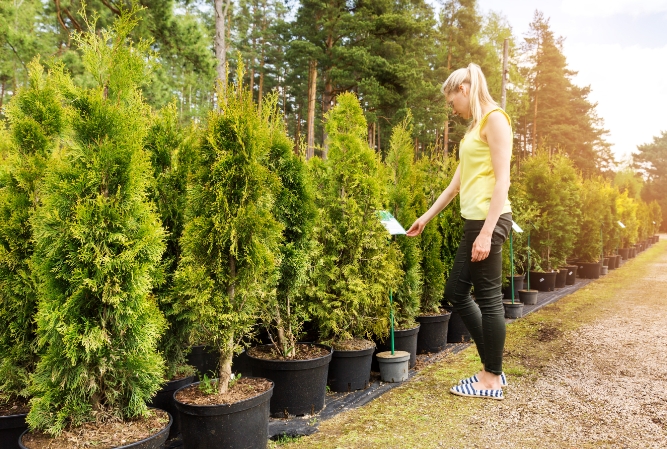Advice From Certified Arborists Near You About Which Trees Are Best for Your Land
Not only do trees boost the curb appeal of any home, but they also provide some much-needed shade during those hot, muggy Midwestern days. However, for a homeowner who is currently working with a blank canvas of a front and backyard, it may be difficult to know what kind of trees to plant on your property.
Obviously, you’ll want to go with something that will provide a nice big canopy over your yard. You’ll also want to go with something that will thrive in this particular climate. Unfortunately, you won’t be able to pick just any ol’ tree, plant it, and expect it to grow to its full potential. That’s the reason we don’t have palm trees here in Kansas. They just can’t hack it here in the Midwest.
As your local certified arborist near you here in Wichita, we’re going to break down some best practices to use when considering new trees to add to your landscaping along with some tree care tips.
Understanding Your Hardiness Planting Zone
In 2012, the U.S. Department of Agriculture released what’s referred to as a Plant Hardiness Zone Map. Essentially, this map shows the various climates and microclimates of the nation. According to the most recent climate statistics, the USDA deems Kansas a growing zone range of 5b through 7a.
Although that may mean nothing to you, it means a lot to arborists and professional tree services in Wichita. Growing zones are a guide to what you can and can’t plant. Before you buy a tree, always make sure that it falls in line with your zone code.
Trees That Can Be Planted in Wichita, Kansas
As a company that specializes in tree service in Wichita, we’re well aware of which trees can be planted in Midwestern zones. We can also tell you which trees are best based upon your yard size and aesthetical preferences. The following four trees are crowd favorites among Wichita residents. The next time you’re considering planting new trees, use this guide to give you some inspiration.
#1 – Flowering Dogwood (Cornus florida)
The flowering dogwood is one of the most popular trees in the Midwest thanks to its ability to provide a pop of color to any landscape. The standard flowering dogwood blooms white flowers; however, there are several other species of dogwood that provide pink and red blossoms and yellow fruit. The flowering dogwood is small in stature, which makes it an ideal choice for those that have a small yard that can’t accommodate an oak or other large tree.
#2 – Ginkgo (Ginkgo biloba)
Native to the country of China, the Ginkgo can reach heights up to 50 ft. and provide a sprawling canopy for shade. It’s a deep-rooted tree, which means it’s highly resistant to wind and snow damage. Kansans love the Ginkgo in the fall because its leaves turn a brilliant gold color. If you get a Ginkgo, just make sure to get a male tree. The female trees produce small fruits that are messy and smell bad. Ask a certified arborist near you about how to tell the difference between male and female Ginkgos.
#3 – Amur Maple (Acer ginnala)
Maple trees are another popular choice among Kansans and Midwesterners. This fall favorite can grow up to 20 ft., which makes it great for medium to large-size yards that need a canopy of shade. Similar to the Ginkgo, the maple shows its true colors in the fall, blossoming with fiery reddish-orange that set a warm campfire aesthetic to any street.
#4 – Oak (Quercus)
The mighty oak is a classic choice for Kansas homeowners. Although they can take up to 30 years to reach full maturity, the payoff is that you’ll have the tallest tree on your block. Oaks can grow up to a whopping 60 feet in height, meaning you’ll have a huge canopy of shade in the summer and a gigantic plume of classic fall foliage during the autumn months.
Questions to Ask Yourself Before Planting New Trees
Before you commit to a tree, it’s important to ask yourself a few questions about tree care and any logistical challenges the tree may pose. For example, planting an oak tree in a small yard may cause problems as it grows in size and its roots expand underground. Any nearby sidewalk is going to be fair game for its roots to disrupt and crack.
Here are few of the most common questions homeowners need to ask:
- Is the tree going to be able to thrive in my zone?
- How much fertilizer, water, and maintenance will the tree need?
- How much will the tree expand above and underground?
- How much yard work is this tree going to cause me?
- In which months does this tree bloom?
You can get the answers to these questions and more by speaking with a certified arborist near you at Huff’s Tree Service.
Contact Huff’s Tree Service About Adding a New Tree to Your Property
Huff’s Tree Service provides a variety of local tree services from a team that you can trust. We provide tree trimming services, removal services, stump grinding, tree and shrub fertilizing, and lot clearing.
The best way to get started is by contacting us directly. You can call us at (316) 871-3841 or email us using the contact form on our website.


